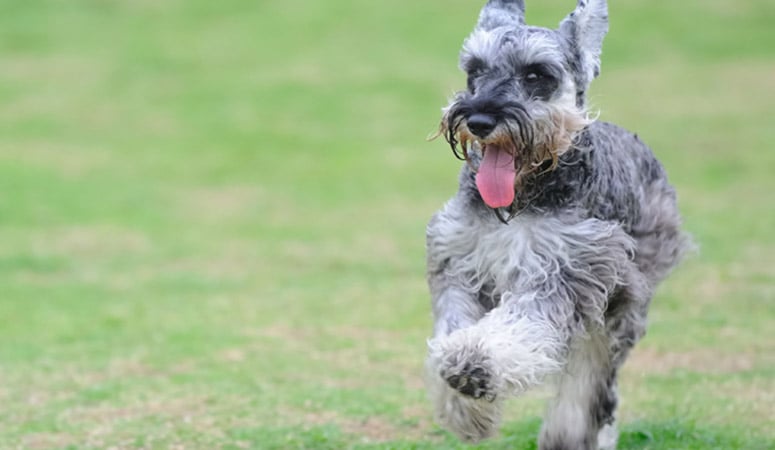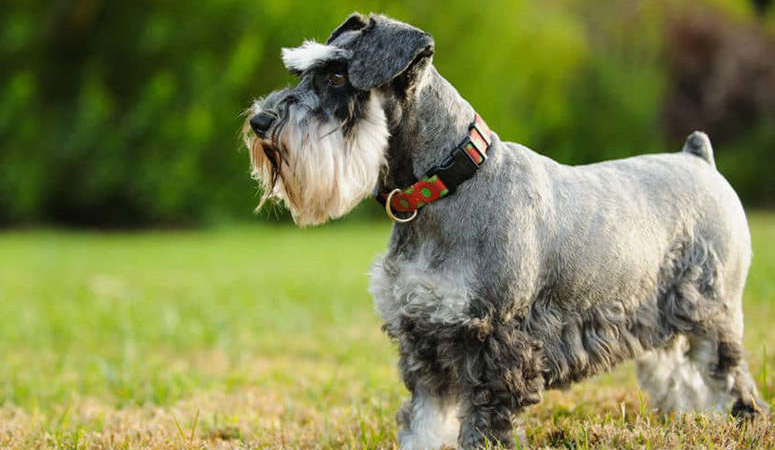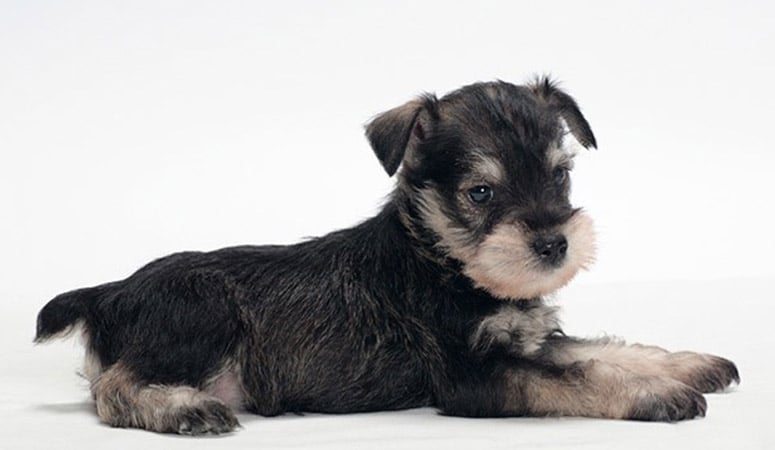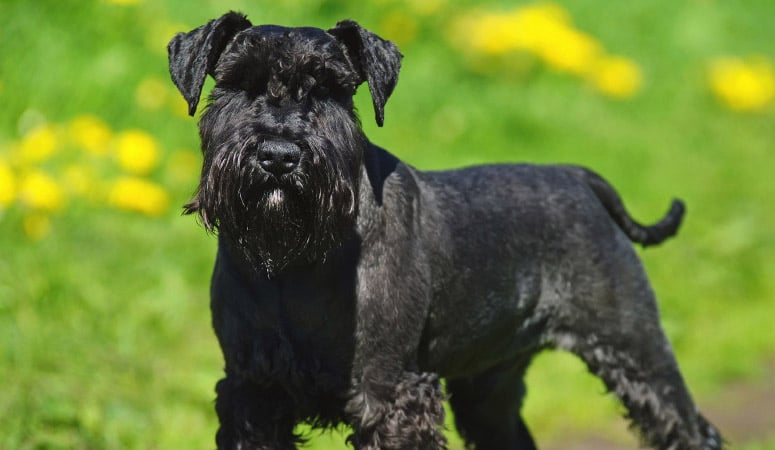Miniature Schnauzer
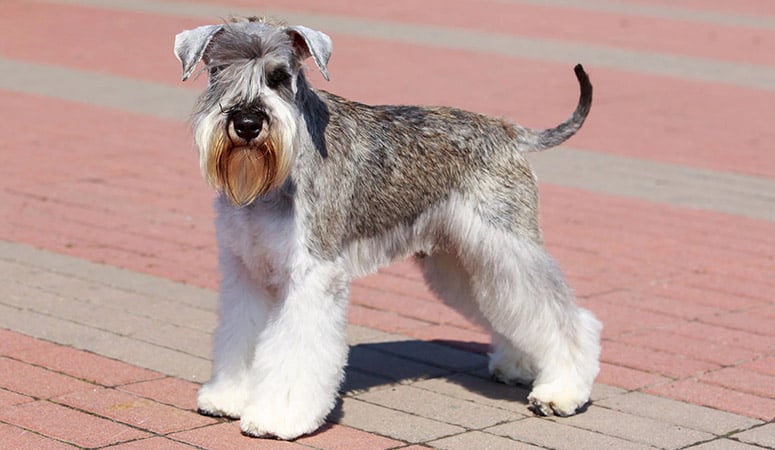
The Miniature Schnauzer is the smallest of the three types of Schnauzer, originated from Germany in the 19th century, this intelligent, affectionate, and friendly dog is a loving companion who likes spending time with his human, in addition to a handy size and sporty good look, and it is the ideal family dog.
| Other Names | Zwergschnauzer |
| Color | Black, Black & Silver, Salt & Pepper |
| Height | Males: 12-14 inches. Females: 12-14 inches. |
| Weight | Males: 9-18 pounds. Females: 9-18 pounds. |
| Life Span | 12-15 years |
| Personality | Friendly, Smart, Obedient |
| Exercise | Regular Exercise |
| Origin |
| Popularity | #18 |
| Groom Needs | Specialty/Professional |
| Kids Friendly | Yes with supervision |
| Dog Friendly | Yes with supervision |
| Watch Dog | |
| Family Dog | |
| Litter Size | 3-8 |
Miniature Schnauzer Pictures
Miniature Schnauzer Video
Introduction
A Miniature Schnauzer, as the name suggests, is a small-sized dog with bushy eyebrows that gives it a human-like appearance. They originated from the Standard Schnauzers of old alongside the Giant Schnauzer. Of the two breeds, the Minis ( a nickname for the Miniature Schnauzers) is the more popular. They come in three variants of colors, all maintaining that hard and wiry coat texture. Black, pepper, and salt, and black and silver are the three varieties of Minis there are.
Despite their little bodies Minis make good watchdogs and are disposed to working really hard and strenuously. Yet they are a cheerful bundle around good company, even with children. Male and female Minis are hardly distinguishable with respect to size. A standard Miniature Schnauzer reaches an even height of 12 or 14 inches and would tip the weighing scales at somewhere between 12 and 20 pounds, a testament to their lightweight.
Miniature Schnauzers are portable and added to the fact that they rarely bite like most dogs, they make the list for great companion dogs. They are small but hardy dogs, scarcely ill (if at all), and would live a full life up to about 13 or 14 years of age.
Living with Miniature Schnauzer
The Miniature Schnauzers shed little, but they need frequent brushing, combing, and grooming to keep neat, because of their double coat – a wiry topcoat and a soft undercoat. Brush your dog two or three times a week so he doesn’t get matted, especially in the longer hair on his face and legs. Besides, the owner could take the dog to professional groomers to trim his coat every five to eight weeks and keep him looking his best. The Miniature Schnauzer needs a bath once a month or as needed depending on his surroundings, and it is suggested to wash his beard after eating.
Check the dog’s ears regularly for the signs of wax buildup, irritation or infection, and clean with a gentle cleanser. Brush the teeth at least two or three times a week to remove tartar buildup and the bacteria that lurk inside it, the daily brush is better to keep fresh breathe and prevent gum disease. And trimming the nails regularly could help prevent painful splitting, cracking, or a broken nail.
The frisky Miniature Schnauzer requires regular daily exercise to run and play and maintain their mental and physical health. This dog breed has a medium energy level and doesn’t tire quickly if he is not given enough exercise, he may be troublesome or mischievous. It is recommended to give 45 minutes to one hour exercise for a Miniature Schnauzer. The Miniature Schnauzer could easily adapt to the country living, or as a good apartment dog once given enough exercise.
Besides, the Mini Schnauzer tends to enjoy and do well at dog parks. It needs to mention that Miniature Schnauzers have a strong prey drive, so the owner shouldn’t allow your dog off-leash when not in a fenced area because he has the urge to chase after small animals.
A special food diet for Miniature Schnauzer may be necessary to prevent urinary stones or food allergies. Generally, it is recommended to food a Miniature Schnauzer with a half to one cup high-quality dry dog food per day, divided into two meals. More importantly, the food amount should depend on the dog’s age, weight, and activity level.
Some dogs are easy to get overweight, so you need to watch their calorie consumption and weight level all the time. Treats may be an important aid in training, but excessive intake can lead to obesity. Also, owners need to distinguish which human food is safe for dogs and which are not. If you have any problems with your dog’s weight or diet, just consult from your veterinarian.
Miniature Schnauzer are prone to the following health conditions including Cataracts, Glaucoma, Epilepsy, Urinary stones, Heart disease, Allergies, Progressive retinal atrophy…
Major concerns: PRA, urolithiasis
Minor concerns: vWD, allergies, myotonia congenita, Schnauzer comedo syndrome
Occasionally seen: retinal dysplasia, cataract, mycobacterium avian infection
Suggested tests:
Cardiac Exam
Ophthalmologist Evaluation
Total Annual Cost: $2674
Cost is estimated for the first year and may vary depending on many factors, such as dog food, health care, leash, collar, licensing, possible fencing, crates, training and obedience classes, dog-walking, grooming, treats, toys, flea, tick, and heart-worm meds, microchips, etc.
Miniature Schnauzers are easy to train and learn basic commands quickly because this dog is ranked as one of the most intelligent dog breeds. The dog should be socialized from puppyhood, and both owners and dogs can benefit from the puppy training classes.
Although this kind of stubborn breed loves asserting independence at any opportunity, they are eager to learn new things. So, short, varied training sessions are best for holding the attention of a Mini Schnauzer.
Furthermore, they are great companions and can excel in a number of canine sports, such as agility, obedience, rally, and earthdog events, and they are also pleased to perform at home as well.
History
The Miniature Schnauzer breed of German roots is a modern breed of a lineage of Schnauzers, favored for its miniature size. The history of this dog breed isn’t an extensive one. The Schnauzers were medium-sized farm dogs in Germany. They were involved in activities that involved herding stock, ratting, and, perhaps, guarding of the farmstead. After some time, breeders thought of developing a smaller breed of the Schnauzer dogs which could crawl into smaller spaces for the purpose of ratting. The report says, the Standard Schnauzers were cross-bred with small-sized dog breeds which probably include the Miniature Pinscher, the Affenpinscher, the Miniature Poodle, or some other smaller breeds. The Miniature Schnauzer emerged with a small size and improved variety of colors in 1888. However, it was in 1899 that the Miniature Schnauzer was first displayed on the show.
In America, the Miniature Schnauzer was introduced around 1924, being imported from Germany. It is probable that modern Miniature Schnauzers in the U.S are descendants of these first set of Miniature Schnauzers in the country. Later, in 1926, the American Kennel Club registered its first Miniature Schnauzer and with time the breed began to gain prominence amongst Americans. The American Miniature Schnauzer Club was later founded in 1933 out of an older club for Wirehaired Pinschers.
Helpful Information
Breed Club: AMERICAN MINIATURE SCHNAUZER CLUB
Breed Club Link: https://www.amsc.us/
Breed Club Rescue:
Breed Club Rescue Link: https://www.amsc.us/rescue/

